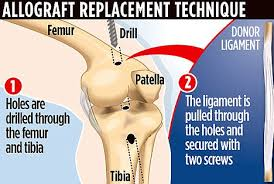ACL Reconstruction in Hosakerehalli, Bangalore
Anterior cruciate ligament (ACL) impairments are common in athletes and people who are physically active. The ACL is one of the knee’s main stabilizers, and its injury can significantly reduce mobility. Orthopedic data on an international level show that ACL damages account for most knee problems annually.
Dr. Nikil S Paramesh, an orthopedic surgeon and a specialist in ACL reconstruction surgery states:
“An ACL injury doesn’t just cause pain—it disrupts mobility, limits independence, and can keep people from doing the activities they love. Without proper treatment, it may lead to long-term knee instability and even early arthritis. My goal is to restore strength and stability, helping patients regain confidence in their movement and return to an active lifestyle.”

Dr. Nikil is well-known for his proficiency with minimally invasive procedures. He is an authority on individualized treatment programs that promote quicker healing and better long-term results.
Understanding ACL Reconstruction
ACL reconstruction surgery is a way of restoring the function of a torn anterior cruciate ligament in the knee. The ACL is responsible for knee stabilization during rotational motion and activities involving braking and suddenly altering direction.
Dr. Nikil S Paramesh, a top choice expert for ACL Reconstruction Surgery in Hosakerehalli, Bangalore explains:
“Once the ACL is ruptured, it will not heal naturally and must be surgically treated to stabilize the knee and restore its function. It is a procedure of replacing the injured ligament with a graft that will act as a platform for the growth of new ligament tissue.”

Types of ACL Reconstruction Surgery Performed by Dr. Nikil S Paramesh
Autograft ACL Reconstruction
This technique makes use of the patient’s own tissue, usually taken from the quadriceps, hamstring, or patellar tendons. Utilizing the patient’s tissue can improve integration and healing while lowering the risk of graft rejection.
ACL Reconstruction Using Allograft
This technique uses cadaveric donor tissue to replace the injured ACL. Allografts can save operating time and postoperative discomfort by eliminating the need for a second site from which to collect tissue. There is a possibility of the body rejecting the donor tissue, but it is small.
Synthetic Graft ACL Reconstruction
Synthetic materials may also be used in reconstructing the ACL, especially where traditional grafts are undesirable. While this operation reduces disease transmission risk and donor site morbidity, it is less commonly performed due to problems with long-term success and graft failure. Studies on synthetic materials continue.
Here’s why patients trust Dr. Paramesh and his team for ACL reconstruction in Hosakerehalli, Bangalore.
Why Choose Dr. Nikil S Paramesh for ACL Reconstruction Surgery?
Unmatched Experience & Skill: With over 12 years of specialized practice in ACL reconstruction Surgery, you can be confident in receiving the highest level of care under Dr. Nikil’s supervision.
Our Approach: Step-by-Step Guide to ACL Reconstruction
In-Depth Consultation: Extensive assessment of your symptoms, lifestyle, and activity level to decide whether you need ACL reconstruction.
Preoperative Evaluation: Special imaging examinations like MRI scans help us select the most suitable type of graft (autograft, allograft, or synthetic). You will also receive specific guidance on how to prepare for surgery.
Surgical Procedure: In minimally invasive surgery, the damaged ACL is replaced with the chosen graft. The procedure takes about 1-2 hours, and patients can typically go home the same day.
Postoperative Care: There is an organized rehab program to regain strength, flexibility, and mobility. Physical therapy is necessary to obtain a complete and safe recovery.

Frequently Asked Questions
How do I know if I require ACL surgery?
If you experience symptoms of knee instability, inability to pivot or turn, or repeated episodes of the knee giving away, it may be the indication of a torn ACL. A thorough examination by an orthopedic physician, including physical examinations and imaging studies like MRI, can determine the extent of the injury and if surgery is indicated.
What is the success rate of ACL reconstruction?
The success of ACL reconstruction is 85-90% in the patients, and they achieve their pre-injury level of activity. Success depends on the surgical technique employed, patient compliance with the rehabilitation protocol, and absence of other knee injury.
When can I go back to sports after ACL reconstruction?
The sports return schedule is usually anywhere from 6 to 12 months after surgery. This varies with:
- the rate of healing
- strength
- functional stability of the knee
You must have a formal rehabilitation program and clearance from your orthopedic surgeon prior to sports return.
What are the complications of ACL reconstruction?
Like with any procedure, ACL reconstruction has some risks, including:
- Infection
- blood clots
- graft failure
- stiffness of the knee
- ongoing instability
But these are usually low, and most individuals do well.
Can ACL heal itself without surgery?
In a few cases, especially in people with partial tears or who are less active, non-surgical methods like bracing and physical therapy will be enough. However, in cases of complete ACL tears, you will need surgical reconstruction to regain full knee stability, particularly in active individuals or athletes.
What is the function of ACL reconstruction surgery in long-term rehabilitation?
ACL reconstruction safeguards joint stability of the knee and prevents further cartilage and other ligament injuries. It allows patients to resume sports and their daily activities.
Disclaimer: The information shared in this content is for educational purposes only and not for promotional use.

